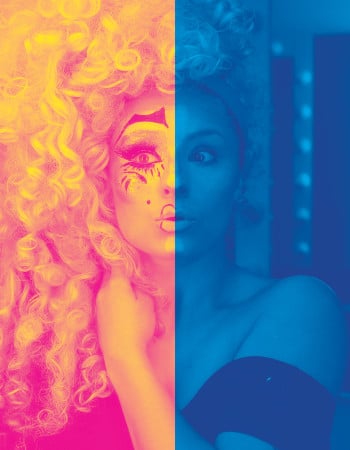A Quick Chat with Jeff Khan
Jeff Khan is the Artistic Director of Performance Space, who are putting up Day for Night, a Sydney Gay and Lesbian Mardi Gras experience. We sent Jeff our questions to find out more about the work, Performance Space, and what makes him tick.
Describe your job – in five words or less.

It’s creative, exhilarating, challenging, rewarding, and diverse.
Tell us about Performance Space, of which you’re artistic director.
Performance Space is Australia’s leading experimental arts organisation. We develop, commission, curate and present work across Sydney that spans different disciplines, genres and thematic territory. We’re based at Carriageworks in inner-city Sydney, and a lot of our work happens in those spaces, but we also present a lot of work in public and non-traditional spaces, as well as partner organisations. In recent years we’ve worked with the MCA, Blacktown Arts Centre and the National Art School, to name a few.
Who are some of your favourite queer artists?
Obviously the Day for Night artists – Bhenji Ra, Matthew Day, White Drummer, Techa Noble, Nell and Emma Maye. Australia has some incredible queer artists, both emerging and established. From Paul Yore to Deborah Kelly, to the Sisters Grimm…queer work is very much alive and kicking in this country!
Which song is stuck in your head right now?
At the moment I’m loving Caribou’s Can’t Do Without You, but Robyn’s Call Your Girlfriend is pretty much always going around my head, all the time.
What are you reading?
Hilary Mantel’s Wolf Hall – getting busy with Thomas Cromwell and the Tudors.
What’s your most memorable performance experience as an audience member?
I loved Willoh S Weiland’s Yelling at Stars in my first ever Next Wave Festival in 2008. A moving, intelligent and witty monologue that was broadcast into space while it was performed at Melbourne’s Sidney Myer Music Bowl.
Who are your role models?
Many of the artists I work with – their ingenuity, their tenacity, and their unflappable and infinitely creative approach to problem solving.
Whose advice do you always take?
I have a few great mentors who are tough but wise. I check in with them as often as I can and their experience and support really means a lot to me.
How would you spend the perfect day off?
At the beach, with a book, and maybe a G&T. Napping would also play a prominent role.
There’s been a lot of talk about the growing size of queer theatre representation in Sydney lately. What does queer performance mean to you?
Queer performance means work that challenges assumptions about gender and sexuality, and that opens up new possibilities for being in the world. For me, queer performance always begins with the body, and asks questions about how our bodies are shaped by the world.
How would you define performance art?
As a label that may or may not be useful for capturing the brilliant, unconventional, inspiring things that artists do with their bodies.
What’s the most exciting thing about your role at Performance Space?
The conversations with artists, developing projects from the beginning of an idea to their final realisation, and making big ideas happen. It’s an incredibly collaborative environment and we have an amazing team of staff who are all really invested in the work we do.
What’s the most challenging thing about it?
Securing the right amount of resources to make these projects happen – fundraising, pulling together support, and the right amount of resources to make them happen in the fullest and best possible way. Our projects are always ambitious and so we’re always working at the edge of what’s possible.
What inspired the creation of the inaugural Day for Night last year?
Performance Space has always nurtured queer artists, and artworks that present new and interesting ideas about gender and sexuality. We’ve also always been an organisation where the broader queer community meets the contemporary art scene, and that mutual encounter is always really exciting. We’re committed to developing strong queer voices in contemporary art, and we want queer work to be a central voice in the broader landscape of Australian art. Day for Night really brings all these things together – it’s our keynote queer project for 2015.
Can you explain how Day for Night works?
This year, Day for Night begins as a huge dance party, in Carriageworks’ largest theatre space. Over the course of the party, six artists will present performances that explore ideas about queer space and time. The next day, the party transforms into a free exhibition where the performances continue and evolve into
What is your personal Day for Night highlight this year?
So many! I can’t wait to see how it transforms from the party to the exhibition.
Which other part of the Mardi Gras Festival are you most excited for this year?
The Queer Thinking program, which features talks and presentations by some of our most progressive and exciting queer minds, is always a highlight. This year Queer Thinking and Day for Night are on the same day, in close proximity to each other, so punters will be able to wander back and forth between the two.
Who are the performers we could expect to encounter throughout the event?
Nell has created an enormous labyrinth on the floor of the space, and she’ll be inviting audiences to walk it with her for the duration of the exhibition.
White Drummer will be occupying a sound-proofed reconstruction of her teenage bedroom for the entire project, drumming along to a soundtrack of the most important songs of her life. It’s kind of like an autobiographical exorcism.
Techa Noble is collaborating with two other dancers to form an incredible composite body invoking the spirit of the Baku, a Japanese deity that devours dreams and nightmares.
Matthew Day will present a series of subtle choreographic interventions into the space, pitting his body against the architecture of Carriageworks.
Emma Maye Gibson’s alter ego, Betty Grumble, will be occupying her own specially-constructed petting zoo for the duration of the project.
Bhenji Ra is teaming up with an amazing, culturally diverse group of Western Sydney dancers – the Pioneers – to explore the appropriation of voguing across different margingal subcultures.
It’s all going to be pretty wild!
Who do you think Day for Night is suitable for?
Beyond the queer audience, Day for Night is for anyone and everyone who is curious about performance, and interested in new ideas about gender, sexuality and the body. Also Friday night’s party will be great for anyone keen to get their dancing shoes on!
Where can we find out more information about Day for Night?
All the details are on the Performance Space website: www.performancespace.com.au

